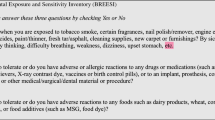Abstract
Purpose
To psychometrically evaluate a Swedish version of the Quick Environment Exposure Sensitivity Inventory (QEESI), originally developed in the United States, which is a sensitive and fast questionnaire instrument with five scales used to investigate chemical intolerance.
Methods
Ninety non-intolerant, 67 mildly intolerant, and 126 moderately/severely intolerant individuals to environmental chemicals responded at test and retest (n = 69, 64, 120, respectively) occasions to the Swedish version of the QEESI.
Results
Good internal consistency (α = 0.74–0.95) and test–retest reliability (r = 0.78–0.93) was found in all scales, except for the internal consistency in the Masking Index (Kuder-Richardson coefficient = 0.10). All scales, but the Masking Index, further showed good convergent validity (somewhat lower in the Other Intolerences scale) and predominantly unidimensionality.
Conclusions
The Swedish version of the QEESI is reliable and valid for investigation of chemical intolerance, but the Masking Index scale does not represent a unified concept of exposure to masking agents.

Similar content being viewed by others
References
Andersson L, Johansson Å, Millqvist E, Nordin S, Bende M (2008) Prevalence and risk factors for chemical sensitivity and sensory hyperreactivity in teenagers. Int J Hyg Environ Health 211:690–697. doi:10.1016/j.ijheh.2008.02.002
Ashford NA, Miller CS (1998) Environmental exposure and sensitivity inventory: chemical exposure: low levels and high stakes. Wiley, New York
Berg ND, Linneberg A, Dirksen A, Elberling J (2008) Prevalence of self-reported symptoms and consequences related to inhalation to airborne chemicals in a Danish general population. Int Arch Occup Environ Health 81:881–887. doi:10.1007/s00420-007-0282-0
Caress SM, Steinemann AC (2003) A review of a two-phase population study of multiple chemical sensitivities. Environ Health Perspect 111:1490–1497
Cullen M (1987) The worker with multiple chemical sensitivities: an overview. Occup Med 2:655–661
Furberg H, Lichtenstein P, Pedersen NL, Thornton L, Bulik CM, Lerman C, Sullivan PF (2008) The STAGE cohort: a prospective study of tobacco use among Swedish twins. Nicotine Tob Res 10:1727–1735. doi:10.1080/14622200802443551
Hausteiner C, Bornschein S, Hansen J, Zilker T, Förstl H (2005) Self-reported chemical sensitivity in Germany: a population-based study. Int J Hyg Environ Health 208:271–278. doi:10.1016/j.ijheh.2005.03.006
Hojo S, Kumano H, Yoshino H, Kakuta K, Ishikawa S (2003) Application of Quick Environment Exposure Sensitivity Inventory (QEESI) for Japanese population: study of reliability and validity of the questionnaire. Toxicol Ind Health 19:41–49. doi:10.1191/0748233703th180oa
Hojo S, Ishikawa S, Kumano H, Miyata M, Sakabe K (2008) Clinical characteristics of physician-diagnosed patients with multiple chemical sensitivity in Japan. Int J Hyg Environ Health 211:682–689. doi:10.1016/j.ijheh.2007.09.007
International Programme on Chemical Safety (IPCS) (1996) Conclusions and recommendations of a workshop on “multiple chemical sensitivities (MCS), Feb. 21–23, Berlin, Germany. Regul Toxicol Pharmacol 24(Suppl):S188–S189. doi:10.1006/rtph.1996.0095
Ishikawa S, Miyata M (1999) Multiple chemical sensitivity-criteria and test methods for diagnosis. Allergol Immunol 6:990–998
Johansson Å, Brämerson A, Millqvist E, Nordin S, Bende M (2005) Prevalence and risk factors for self-reported odor intolerance: the Skövde population-based study. Int Arch Occup Environ Health 78:559–564. doi:10.1007/s00420-005-0616-8
Johansson Å, Millqvist E, Nordin S, Bende M (2006) Relationship between self-reported odor intolerance and sensitivity to inhaled capsaicin: proposed definition of airway sensory hyperreactivity and estimation of its prevalence. Chest 129:1623–1628. doi:10.1378/chest.129.6.1623
Kreutzer R, Neutra RR, Lashuay N (1999) Prevalence of people reporting sensitivities to chemicals in the general population. Am J Epidemiol 150:1–12
Manabe R, Kunugita N, Katoh T, Kuroda Y, Akiyama Y, Yamano Y, Uchiyama I, Arashidani K (2008) Questionnaire survey of workers in specific buildings regarding multiple chemical sensitivity. Nippon Eiseigaku Zasshi 63:717–723. doi:10.1265/jjh.63.717
Meggs WJ, Dunn KA, Bloch RM, Goodman PE, Davidoff AL (1996) Prevalence and nature of allergy and chemical sensitivity in a general population. Arch Environ Health 53:275–282
Miller C (1997) Toxicant-induced loss of tolerance—an emerging theory of disease. Environ Health Perspect 105(suppl 2):445–453. doi:10.2307/3433351
Miller CS (2001a) Toxicant-induced loss of tolerance. J Nutr Environ Med 11:181–204. doi:10.1080/13590840120088056
Miller CS (2001b) The compelling anomaly of chemical intolerance. Ann NY Acad Sci 933:1–23
Miller CS, Prihoda TJ (1999a) The Environmental Exposure and Sensitivity Inventory (EESI): a standardized approach for measuring chemical intolerances for research and clinical applications. Toxicol Ind Health 15:370–385
Miller CS, Prihoda TJ (1999b) A controlled comparison of symptoms and chemical intolerances reported by Gulf War veterans, implant recipients and persons with multiple chemical sensitivity. Toxicol Ind Health 15:386–397
Nordin S, Millqvist E, Löwhagen O, Bende M (2003) The chemical sensitivity scale: psychometric properties and comparison with the noise sensitivity scale. J Environ Psychol 23:357–365. doi:10.1016/S0272-4944(03)00002-1
Nordin S, Bende M, Millqvist E (2004) Normative data for the chemical sensitivity scale. J Environ Psychol 24:399–403. doi:10.1016/S0272-4944(03)00074-4
Acknowledgments
This study was supported by grants from the Asthma and Allergy Association’s Research Fund to SN. We gratefully acknowledge Eva Bringlöv for excellent assistance. We are most thankful to Dr. Claudia Miller for permission to translate the QEESI to Swedish and evaluate that version for future use. We declare no conflict of interest.
Author information
Authors and Affiliations
Corresponding author
Rights and permissions
About this article
Cite this article
Nordin, S., Andersson, L. Evaluation of a Swedish version of the Quick Environmental Exposure and Sensitivity Inventory. Int Arch Occup Environ Health 83, 95–104 (2010). https://doi.org/10.1007/s00420-009-0427-4
Received:
Accepted:
Published:
Issue Date:
DOI: https://doi.org/10.1007/s00420-009-0427-4




